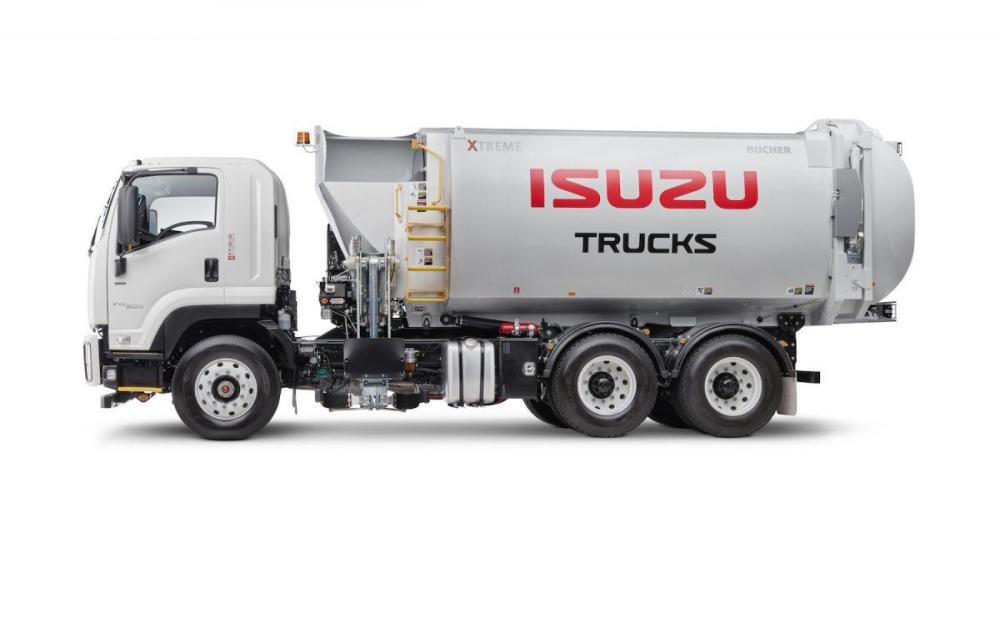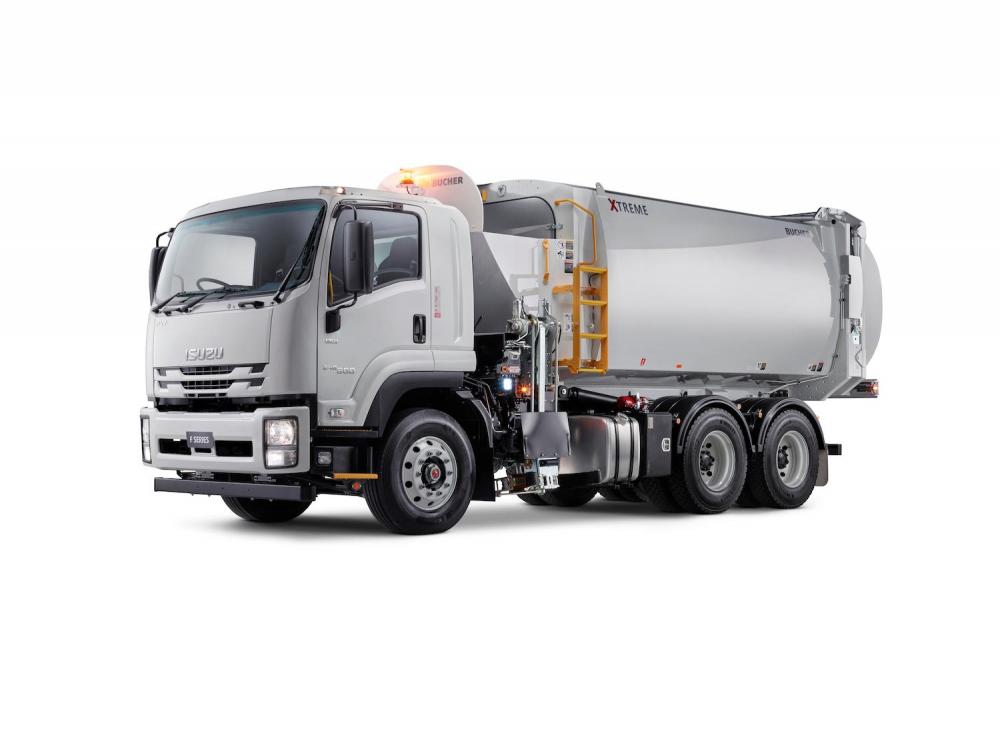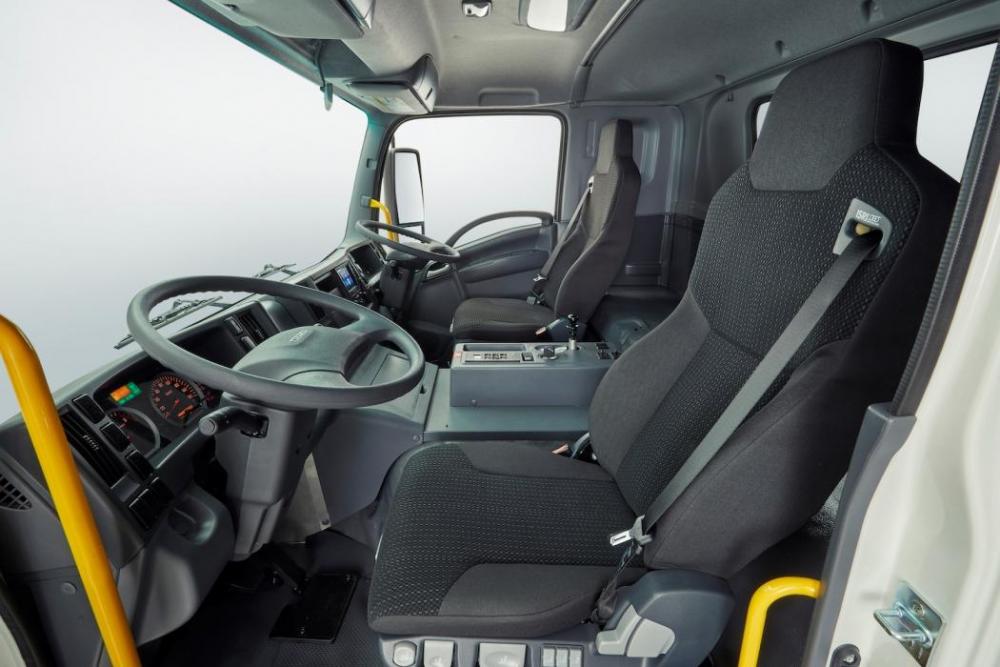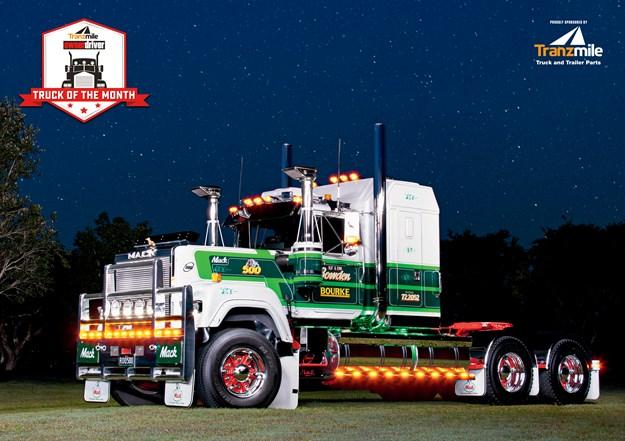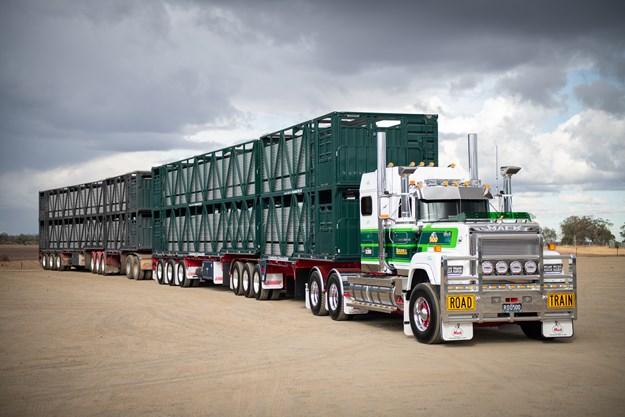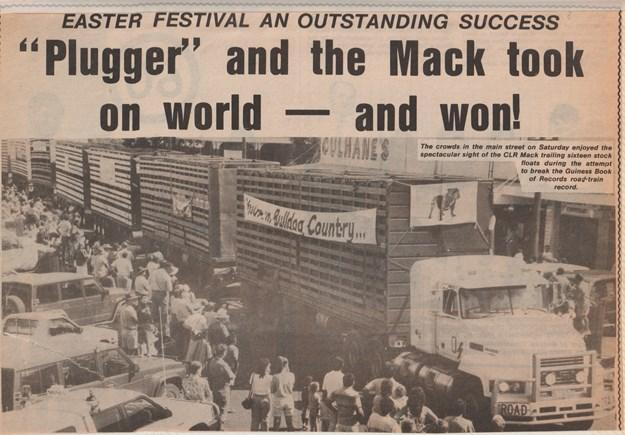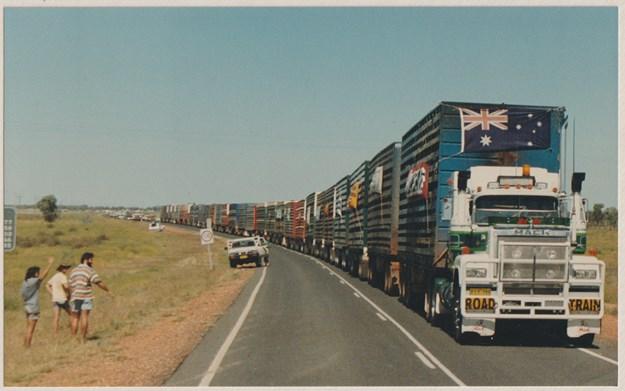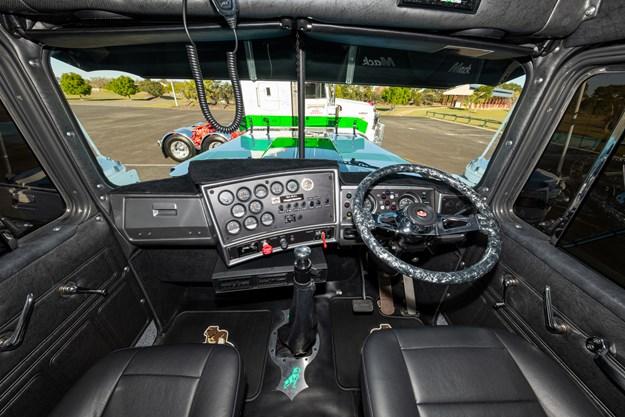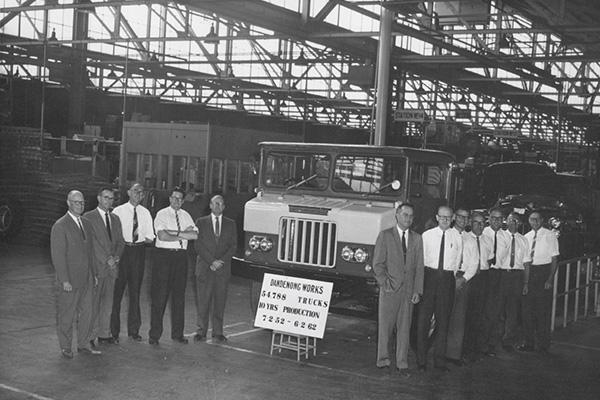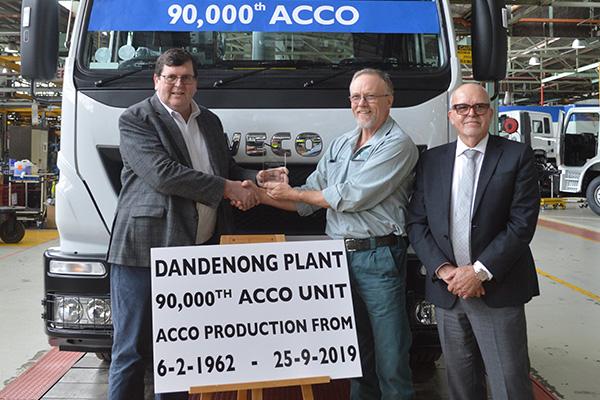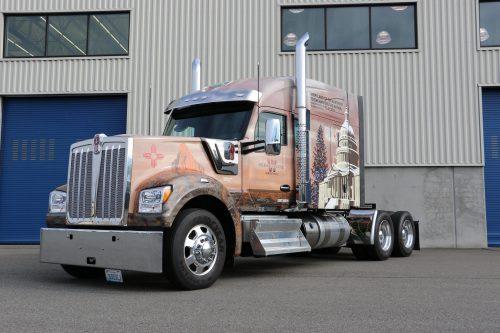
kscarbel2
Moderator-
Posts
18,541 -
Joined
-
Days Won
112
Content Type
Profiles
Forums
Gallery
Events
Blogs
BMT Wiki
Collections
Store
Everything posted by kscarbel2
-
Renault Trucks Press Release / November 6, 2019
-
Renault Trucks Press Release / October 8, 2019 .
-
. .
-
Cummins Press Release / November 8, 2019 Cummins Inc. (NYSE: CMI) announced today that the X12+Endurant powertrain from its Integrated Power portfolio is now available for customers in regional haul applications, delivering the lightest solution to this market with industry-leading maintenance intervals. Following Freightliner’s announcement at Tank Truck Week in Nashville, TN, this lightweight powertrain from Cummins can be now be ordered in Freightliner's brand new Cascadia 116' BBC Day Cab. This is a new market for the X12 engine, which has exclusively been available in vocational and refuse trucks before now. "The X12+Endurant powertrain's lightweight, yet durable design allows customers to maximize their payload for each and every job," said Amy Boerger, Vice President – Engine Business Sales for Cummins. "We wanted to create the optimal powertrain solution for customers with weight-sensitive applications, and we are confident this is it." At just over 2,700 pounds, the X12 paired with the Eaton Cummins Endurant transmission is expected to be to be the lightest powertrain available for the Class 8 on-highway market. It is a perfect match for weight-sensitive markets like bulk and regional haul applications. Driver-friendly features from the Endurant transmission like smooth shifting and quiet engine performance contribute to a comfortable in-cab environment, while Optimized Urge to Move and Creep Mode make maneuvering in low-speed environments easier. "We are thrilled that the X12 will now be available in the Freightliner Cascadia 116 BBC model," said Paul Rosa, Penske Truck Leasing senior vice president of procurement and fleet planning. "This new offering makes for a great weight-conscious solution and will be a nice option for our customers." Expanded availability of the X12 comes at the perfect time, as Cummins is expanding maintenance intervals for the platform. Customers can benefit from oil-drain intervals of up to 75,000 miles, and those that participate in Cummins OilGuard program may see extensions of up to 100,000 miles. Together with the Endurant, which offers a 750,000 mile lube change interval and a maintenance-free clutch, you’ve got a powertrain with the industry’s best maintenance intervals. The 116" BBC day cab Cascadia with the Cummins X12 and Eaton Cummins Endurant begins production mid-2020. The Freightliner Cascadia is also available with the Cummins X15 Efficiency series engine and the Eaton Cummins Endurant in the 126" BBC day cab and sleeper models.
-
Diesel News Australia / November 2019 The release of its new Dual Control truck range sees Isuzu focusing on the waste industry in a much more concentrated way. This refocus may have been stimulated by uncertainty around the future of models like the Iveco Acco. The latest announcement from the top selling truck brand in Australia is the launch of an all new Dual Control waste and refuse truck line-up with four models available (plus wheelbase options). Developed in Australia and based on the FSR 140-260 4×2 Dual Control model, the new, expanded dual control range features Isuzu axles, multi-leaf steel spring rear suspension, dual circuit air over hydraulic front and rear drum brakes with ABS, Allison LCT 2500 transmission and ISRI 6860 with integrated seatbelt in both left and right hand driver positions. The new 16,500 kg and 24,000 kg GVM dual control models feature Hendrickson airbag rear suspension, which delivers substantial tare weight advantages – a key advantage over competing brands. The new FVZ dual control models use Isuzu’s 6-rod and trunnion taper leaf type rear suspension, offering cross-articulation for work in arduous terrain, for example at a waste processing facility. Other key components in the FVD, FVZ and FVY Dual Control models include Meritor axles, with the FVZ and FVY featuring the MT44-144 rear axle tandem set with driver-controlled inter-axle lock and cross-locks on both axles. Brakes are Meritor Q-Plus dual circuit full air ‘S-cam’ front and rear brakes with auto slack adjusters and ABS as standard. “We’re extremely pleased to be able to bring additional factory dual control solutions to market,” said Les Spaltman, Isuzu National Sales Manager. “Many would be aware of the discontinuation of some of the more traditional, go-to truck models in this sector. In response, we have a highly competitive, low tare weight solution on offer, one which ticks some key boxes for Australian operators.” All Isuzu dual control models also come equipped with Allison automatic transmission as standard equipment, from the LCT 2500 Series in the FSR, through to the rugged 3000 Series in the FVD model and the 3500 Series in the FVZ and FVY 6×4 variants. The instrument panel has been duplicated on the left-hand driving side and both driving positions feature air-assisted steering wheel height adjustment for complete driver customisation and control. The design also retains existing cab electrical harnessing, with ‘plug and play’ additional wiring harnesses. Fresh safety elements include interlocks for control change overs, safety yellow grab handles and steps, along with Isuzu’s existing safety suite including ABS, RHS driver airbag and cornering lamps for urban laneway safety. “What we’ve worked really hard to develop with these new models is a compelling total cost of ownership argument for Isuzu,” said Les. “Lower tare weights bring improved productivity and payload. And when you add the commonality of parts we’ve developed with our F Series range, the equation really adds up in favour of our customers. “These trucks have been designed specifically for Australian conditions and industry need. We have incorporated proven efficiencies across our engines, driveline and chassis componentry, wheelbase options and in-cab appointments, making this dual control line-up extremely competitive on a number of fronts. “We know that when it comes to the waste and refuse industry, reliability, economy and durability are non-negotiables. We believe these new models have these qualities in spades.” .
-
Trade Trucks Australia / October 3, 2019 Welcome folks, before we begin, I recommend everyone do a quick status check, is your beer cold? Have you got some chips to crunch on? Have you emptied your bladder? Because I’m inviting you to sit down and enjoy a story I’ve been waiting 17 months to write. For those dubious about the level of amusement involved, well when you’ve got a story that involves names like Plugger, Ferret, Tart, Bullbar Bob, Burloo, Popeye and even Festus, I think you can be assured it’s an interesting tale. By now I’m sure you have already flicked through the photos accompanying this piece and after wiping the drool off your chin have come to the same conclusion as countless other truck fans: "DAMN that’s a fine-looking Superliner" – and you would be right. Now, however, you have come back to read the story and learn a bit more about it. So welcome, let me take you back to May 2018. That’s when the marvellous world of Facebook connected a very young workshop manager with yours truly. "Hey Bud. I’m doing up a V8 ‘88 model Superliner in my workshop in Toowoomba atm. The truck’s got a bit of history behind it." That was the understated opening to the message I got from Mark Holt, the afore-mentioned workshop manager. He finished the introduction with the almost redundant statement: "Let me know if you’re interested in having a look at it." I mean, seriously, does a bear crap in the woods? Does Dolly Parton sleep on her back? He had me at V8 ‘88 Superliner! KEEP IT IN THE FAMILY Of course, I acted more like a professional journalist than a giddy schoolboy when I replied, but the end result was that we kept in constant communication as the rebuild took place. Many progress photos were sent by Mark, and to be honest, it kind of felt like finding dad’s Penthouse collection as I hid away from others just to enjoy the view. Not that I ever found dad’s collection – I was way too busy studying and assisting the elderly, I promise. The Superliner’s progress was stunning. The quality of the workmanship from all involved as she grew alive again was just breathtaking to watch. Finally, 15 months after first chatting with Mark, and only days before its debut at the Casino Truck show, I pulled up to BlingHQ in Hattonvale, Qld, where the truck was getting detailed and laid eyes on one of the most impressive resurrections I’ve seen. A 1988 MKII V8 Superliner, and not just any Superliner, but a world record-setting MKII V8 Superliner. Whilst all the hard work was getting put into making the truck look good (and I will get to that shortly) I started researching, as Mark underwhelmingly put it, the "bit of history behind it". Kevin ‘Plugger’ Bowden is the name on the door and the truck is best known for its miraculous feat of strength, back in 1994, when it set the world record for the longest ever road train towed. A total of 29 stock trailers and 28 dollies linked together like one of those childhood-toy snakes, only much, much longer. Even the tale behind that is typically Aussie. However, first I think we need to appreciate just how much influence the entire Bowden family has had over generations of trucking. Even to this day the name is still synonymous with hard work, helping hands and highway legends. Kevin never really had a choice about what industry he would end up in, it’s in the family DNA. The diesel veins can be traced back to the end of the horse and cart era and ironically the introduction of the petrol-powered big rigs. Kevin’s grandfather Albert is ground zero for the family story. Originally an engineer on paddle steamers, Albert moved the family, which included Kevin’s dad Cyril and Cyril’s two brothers, from Wilcannia to Bourke in 1922. In 1926, AL Bowden & Sons picked up the mail contract between Bourke and Wanarring, returning with wool to Sydney to help make extra coin. It was this service that would serve as the backbone of AL Bowden & Sons for several decades. Through the harsh NSW conditions of the time, that included corrugated roads deep enough to lose one of the Bowden’s old Leyland, dodges or Reos the family used to move mail and wool throughout the year to keep the bills paid. There are records kept that in 1933 the Bowdens, including Kevin’s Dad Cyril who had started driving the year before with a permit as he was only 17, moved 5,200 bales of wool. That’s not bad when you think about how much should ‘legally’ have been on a truck in that era. I’m no rocket scientist but I’m pretty sure the maths equates to the odd overload. It wasn’t just their tenacity to hook in that spawned the Bowden legacy, it was their adaptability as well. Case in point, the ‘Mulga Supergrade’. Adaptability at its best. The Mulga Supergrade was a coal powered fuel system that the Bowdens ran on their trucks during World War 2. They ran it because fuel rationing meant they were only allotted enough fuel to complete the delivery of their mail run, not enough to get the trucks back. The system was installed and sure, it pulled like a derated 909, but it did get the boys home again. The Bowdens were a family that battled in the toughest conditions and as a family they thrived. AL Bowden and Sons trading up until the 1960s, at that stage Kevin’s Dad Cyril took over and began trading as CA Bowden & Sons. Kevin, along with his brothers Ronald (Ferret) and Bruce (Tart) moved the family business into the livestock industry. They continued the mail service as well as general freight though by that time the livestock had them as far afield as Darwin and Townsville. In 1964, the Bowdens joined much of the Bourke shire in placing a Bulldog Mack in the fleet colours. The EH Mack was followed a couple of years later by their first B-model Mack. With the trucks working with, let’s say, more than impressive loads, along with covering some tough landscapes, the Macks proved their worth and remained the staple diet for CA Bowden & Sons. NEW ERA The family worked as one for a few more decades before eventually splitting up in the early ‘80s and the sons branched out on their own. Sadly, Cyril passed away in late 1988 almost a decade after he was awarded the British Empire Medal for his services to the transport industry. Cyril’s love of the country and the transport industry was evident in everything he did and thankfully for the next generation they followed in their father’s footsteps. As the early nineties rolled in, Kevin was running his own truck under the Kevin Bowden banner, a R-model Mack still doing livestock all over the countryside. Plugger’s R-model was then replaced with one MKI Superliner, though this may purely have been because he was sick of sleeping across the seats of the R-model. Plugger’s driver at the time, a young Wayne ‘Pie’ Parry actually informs me that Plugger very nearly ended up with one of the Bi-centennials. "Yeah, Mack actually rung Plugger to offer him one of the Bi-centennials," says Pie, "but the work was a bit on/off and he couldn’t really justify it." Wayne grins as he then informs me that not long after, the rains came and the work went through the roof. Plugger rung Mack and ordered the MKII, speccing it out with the bigger bunk and looking a lot like the limited-edition Bi-centennials. Pie also informed me a little of the early history of the truck. I’m not referring to his joy as a 25-year-old to be sharing such a rig with Plugger, nope. I’m referring to the fact it didn’t make it far out of Sydney on its maiden journey. "Coming out of Sydney, she started pressurizing the radiator. Brand new, she dropped a liner," Pie tells me. He goes on to explain that it was taken back, stripped down and all fixed up. At that point they rung Plugger to inform him it was all good to go; they’d had it on the Dyno and it was putting out 460 something at the wheels. In a typical Plugger response he pointed out he’d paid for a 500, so if it’s not putting 500 out at the wheels then don’t bother bringing it out. The language was a little more colourful but I’ll keep it PG. Plugger’s effect on the industry was much more far reaching than just the road train records; before he even set the first one in 1993 he was also the first operator in Bourke to bring in a four deck crate. Like any new idea it was scoffed at but Plugger knew what he was doing and they are now a staple of the industry. RECORD BREAKER So, I think I’ve brought us up to the moment that made Plugger and his truck famous. Now, however the details of the pull are told best by another icon, Bob Hayward. Bob was the man behind the hugely successful Bourke radio show, ‘Trucks and Tracks’. It was an idea dreamed up by Bob at 3am one morning and laughed at by his director. Like Plugger’s four deck crate it went on to become a huge hit; interviewing all manner of people affiliated with the transport industry and getting a lot of people talking. It also introduced Bob to a lot of the local operators, including Plugger. This introduction came in handy when Bob and his mate Andrew Aitchison heard that a road train record of 14 trailers had been set in Winton in 1993. Bob and Andrew were adamant: "We can do it better in Bourke." Even Mack were on board. Lending a heavy duty CLR Mack with hub reduction, they hooked 16 trailers up to set a new record, and who else could drive it but Plugger? Within a year that record had been surpassed up in Darwin. Though Bob points out that it "shouldn’t have counted – they had empty flattops, an empty tanker, but we did it all with stock crates". So, come 1994, Bourke wanted their title back and the bush telegraph had trailers rolling in from every operator and company within miles of Bourke. The end result was 29 trailers – a total of just over 439 metres of tyres and crates, weighing around 500 tonnes. Now, what I didn’t know was that it wasn’t meant to be Plugger’s truck at the front. Mack were building a huge heavy spec rig for the task, which sadly wasn’t ready in time. Bob informs me that the news was broken to him a couple weeks out from D-day. "I rung Plugger, as he was going to drive it again, and told him ‘you’re not gunna believe it old son, we don’t have a truck’," Bob recalls. "Plugger said straight away ‘we’ll use mine’." Bob laughs as he recalls the impracticality of the offer, pointing out to Plugger its highway rated diffs, the fact it didn’t have hub reductions and it was only 110t rated. Bob also vividly recalls Plugger’s matter-of fact-response to Bob’s scepticism: "I reckon we can do it easy!" Doing it easy wasn’t really the way it rolled out to be honest. The whole town assisted in getting the unit together and eventually Plugger had the big Superliner in place. It was at this point that Bob, who along with his son was sitting in the truck beside Plugger, learnt a little bit about the Bowden appreciation of history. "Plugger remembers the old blokes talking about horses and how before they stepped the horses off, they pushed them back in the traces so everything was slack and as they took their first step the weight would come on after they were mobile," Bob informs me. He then explains how Plugger took that notion and pushed back himself. All be it, when he pushed back on 29 trailers there may have been a good metre of clicking back. When he threw it forward, the big bonnet went up, the black smoke rolled and, as Bob admits, "We now know all that weight went straight into that rear diff," and that rear diff shattered. Bob admits to a moment of panic from inside the cabin, hearing that noise, but when he asked Plugger what the hell had happened, his response was: "I don’t know Bobby, but she’s still going." Bob insisted Plugger pull it up. Instead, Plugger’s grin and the fact that he threw another gear into her at full noise showed that he wasn’t giving up. The Big Mack didn’t either, getting up to almost 28km/h before the other organiser Andrew, screamed out over the two-way to pull her up as the rear trailer had clipped in on a power pole. Like most things back in that era you learnt by experience. Looking back now, Plugger and Bob admit they should have realised that the Big Mack had air enough for only six trailers, so one through six braked beautifully when required. Seven through 29 went in their own direction. There was a bit of pressure on a couple of dollies, a couple of broken drawbars and a very startled police officer who had his back to the truck when the drawback snapped, subsequently scaring 10 years off of his life. By the time the whole lot had all been dismantled and a couple of blokes had run the hat around the appreciative crowd, they had raised enough money to cover all the repairs. The boys all enjoyed a great laugh at the bowls club and the record was returned to Bourke, where it belonged. That day in 1994 was Plugger’s most public feat but it was far from his crowning glory. The generosity and spirit of the Bowden family has carried on to this day. Plugger and his lovely wife Dot carried on running the Superliner, moving into tipper work when the weather conditions saw dramatic falls in stock numbers. Eventually, due to ill health, Plugger sold the Mack to his nephew Mark (Popeye) Bowden. In August 2007, two years after selling the MKII, Kevin ‘Plugger’ Bowden passed away and was laid to rest in Bourke. NEW PASTURES Now we jump ahead six years, I’m sure in movie language there’s a technical phrase for skipping ahead but I’m just going to call it lazy writing. 2013 was a very special year in the life of Plugger Bowden’s Mack. That was the year that new owners got their hands on the 1988 Superliner. Mark ‘Popeye’ Bowden, who had bought the truck from Plugger, wasn’t in a hurry to sell the old girl but when an offer came from a family steeped in trucking history and with a respect for the Superliners past, it wasn’t a tough call to make. The truck was put on the back of a float and sent up to a workshop in Toowoomba. Funnily enough, when the truck was rolled off the float, one of the first people there to see it was Wayne ‘Pie’ Parry, Plugger’s driver when he had bought the truck. Like excited schoolboys, Pie and the new owner jumped in and took her for a quick spin. "She definitely needs a bit of work," was the comment made when the brake-pedal struggled to do the one thing required of it: brake. After its action-packed test drive the truck was handed off to Vanfit Diesel owner, Mark Van Dongen, who was tasked with stripping her back to bare bones. "It was well used" and "it was buggered" were two of the initial comments from Mark when he laid eyes on it for the first time. Plenty of hours were spent on the rails, cross members and running gear. After the tear down, Mark set about needle gunning the rails and getting the running gear back to working. From there, he moved onto other work and the resurrection process was shelved. Once again, we will jump ahead – this time to November 2017 when another Mark – Mark Holt, the man I met on Facebook – started as workshop foreman and with a lot of help from Nicolas Ball, the Bowden Superliner was a topic of conversation again. Mark Holt’s history in rebuilds, as far as I can tell, is limited to throwing his Lego around the room when he couldn’t get the wheels on the race car he was building at primary school. His history with tools and machinery though is much more expansive. Starting as an agricultural apprentice back in Albury, before working on trucks, he took those skills to the thriving metropolis of Kalgoorlie, and after some more youthful adventure he ended up in Toowoomba. His first run in with Nicolas (who coincidentally before the Bowden’s truck had a very similar level of rebuild experience) was there in Toowoomba. The two hit it off and by the time Mark found himself as a workshop manager he once again had Nic working alongside him. When Mark was handed the keys to the shed with pallets of parts and a couple of chassis rails, he made sure Nic was beside him. BACK TO LIFE It may have seemed a fairly incomprehensible mountain to climb for two guys that have never undertaken such a huge project, especially as Nic describes himself as "a trailer mechanic trying to make it to the front end", but Nic also points out that it was Mark’s managerial skills that broke the project down into accomplishable linear problems. There were definitely a few of those: working out an airline system without any cheat sheet; an exhaust setup that confused the pros and resulted in Mark and Nic building it themselves; different sized fuel tanks, different sized J brackets – oh, this truck threw everything at them. The boys dug in though and whilst also running the workshop and fleet maintenance, they tackled each problem and worked out a solution. Engineering issues took up the majority of the first few months, getting everything checked and specked. The team at Darling Downs Engineering were instrumental in so much of the engineering rebuild; repairing old parts and fabricating replacements. Mark and Nic are good, but they were happy to let the big boys do that stuff. Mark is also very quick to express his gratitude to Greg Burling from Toowoomba Truck Spares for plenty of advice and assistance getting the work done. "He’s the man to talk to about old Superliners," Mark states. Interior work was another major issue. The whole bonnet cab and bunk had been taken off and stored during the original tear down and the interior needed to be ripped out and replaced. Personally, I think the reo bar welded in to hold up the dash may have been an artistic addition but instead, the bonnet bunk and cab were sent to Peter Mac Truck repairs for extensive work, whilst the interior repairs were left in the hands of Toowoomba Trimming, who did a fantastic job restoring it. Even down to hand-sewn pieces in the bunk and custom leather seats. Mark firmly believes the interior is the best part of the rebuild. Along with changing the dash colour to a stunning metallic grey, Mark took it upon himself to add in a PearlCraft steering wheel and gearstick head, which finished it off beautifully. Now, if Mark and Nic had mountains to overcome, I’m pretty sure motor wizard Dean Conway had to skydive from 30,000ft to see his issues. One of the few things the new owner was insistent on was finding the big 500’s original motor to go back in. Finding the motor, no worries, it was becoming part of the landscape in a Bourke paddock. Getting it back to Toowoomba, easy as; on pallet, on truck. Getting it going, well that was tougher than a BBQ bush turkey. Who would do it was never in question though; Dean Conway from Toowoomba was the man for the job. Dean grew up with Plugger’s grandsons and had strong ties to the family. In fact, his father-in-law was none other than Wayne ‘Pie’ Parry himself. So how much work was needed? "It had been laying in the paddock in the dirt, everything had been robbed off it over the years and I thought ‘here we go’," Dean recalls. He goes on to explain a few minor issues he had to deal with. "I drained the sump and there was about 20 litres of water in the sump [and] five of the eight pistons were rusted in. I thought ‘Jeeze we’re in the shit here!’" It ended up taking Dean about nine hours to get the pistons out and more than once he thought it wasn’t possible. But it got machined, four new heads, new pistons liners, the crankshaft machined, everything that could have been replaced was. Dean admits though that he did get a bit more out of the fuel pump, so if it ever does get on the dino, Plugger can be sure it’s giving more than he paid for. All up, Dean had the engine for two years before he fired it up on the back of the trailer. "First start of an engine you’ve built is always a special one, but this was a bit more," Dean tells me, and like everyone else involved you could really tell the importance of this build. With the motor running, the wheels turning, the replicated paint work done perfectly by Peter Mac Truck Repairs and Sam Keddie coming in to do the standout signwriting, the truck was looking flasher than a rat with a gold tooth and a wrist full of Rolexes. Last, but not least, was the added bling. From the stainless wrapped tanks to the polished bullbar, the drop visor to the chrome air intakes - the truck just pops. A lot was done inhouse by Mark, Nic and the team and what wasn’t was made and fitted by Ryan at BlingHQ. There was the temptation to keep the truck all original, but the truck was bought by a truck-loving family with a fleet of stunning rigs themselves. They have done a fantastic job of bringing back to life an iconic truck, paying tribute to a legendary man and a great family. They’ve done this whilst adding their own high-class standards and they have nailed it. So, after wearing my fingers to the bone on the keyboard and filling my hard drive chock-full of Superliner photos, it’s time to wrap up. If I’ve worked this out correctly, you should have been able to read this whilst walking about 878.338m, or up and down a Mack road train with 28 dollies and 29 trailers. .
-
- 1
-

-
Iveco Trucks / October 1, 2019 In 1962, the first civilian AACO (Australian A-line Cab Over) models left the production line at International Harvester’s Dandenong, Melbourne, production works. Some 57 years later, IVECO is celebrating the delivery of the 90,000th ACCO (Australian C-line Cab Over), a name change affected following a move from the ‘A’ to ‘C’ production line. ACCO number 90,000, a 6x4 model, was handed over to long term IVECO customer, Solo Resource Recovery, a company that has purchased over 1000 ACCO trucks over the last 30 years. In a small ceremony held last week at the end of the production line, IVECO Australia Business Director, Bruce Healy, presented the vehicle and a commemorative plaque to Solo Resource Recovery National Fleet Manager, David Hancock, while sharing his thoughts on the ACCO’s proud Australian heritage. “It gives me much pleasure today to be part of celebrating a momentous milestone for the ACCO model, and for Australian commercial vehicle manufacturing as a whole,” Mr Healy said. “The ACCO is an Australian transport industry icon and has proven to be a real survivor, as its longevity and high production numbers will attest. “A combination of rugged construction, reliability, fit-for-purpose design and local engineering have made it a favourite for decades, particularly in demanding applications.” With a new generation Euro6 ACCO shortly to be launched in Australia, Mr Healy said that IVECO was looking forward to building on the nameplate’s proud heritage well into the future. “The new Euro6 ACCO will continue to be manufactured in Australia and will enjoy many of the same benefits that held its predecessors in good stead for so many years,” he said. “To this proven equation we’re also adding the latest in emissions technology, safety features and driver appointments, making the next generation of truck an ACCO like no other.” In receiving the 90,000th ACCO, David Hancock, said he was grateful for the excellent service that the ACCO range and IVECO had provided to Solo Resource Recovery over many years. “The ACCO has been a staple of Solo Resource Recovery’s fleet nationwide for a long time,” Mr Hancock said. “We operate 4x2, 6x4 and 8x4 ACCO variants in a range of compactor, hook lift, front end loaders, tankers, ‘RoRo’ (Roll-on / Roll-off) and rear loader operations, and currently have over 500 ACCO units in our fleet. “There is a reason why we keep using these trucks – for the tough, start and stop work that is part and parcel of refuse collection, it’s difficult to go past the ACCO. “The trucks are also straightforward to maintain, easy for bodybuilders to build on and the service we receive from IVECO in supporting the range is excellent,” he said. Despite carrying the mantle of 90,000th ACCO, this new truck will not lead an easy life and will shortly go into service at Tweed Heads as a rigid tanker. .
-
Isuzu Trucks Australia / November 5, 2019 Truckpower On The Road paid a visit to the South Australia Country Fire Service to learn about how they use Isuzu trucks in battling nature's extremes. .
-
Diesel News Australia / November 2019 The answer to the question, who needs an engine brake? is, of course everyone, in a truck. However, the way technology is developing is likely to make the famous Jake Brake just a little less important in the scheme of the things, in truck development of the future. Recent developments have seen the increased use of transmission retarders in truck design, as demonstrated in this video. The Intarder from ZF has started appearing in many European truck designs. Truck brands like Scania, MAN, DAF and Isuzu include retarders in their top-end prime movers as a matter of course. Including a retarder doesn’t preclude including a compression engine brake. Many have both and use the brake blending techniques of exhaust brake, then engine brake, then retarder and finally service brake as a cascading method of bringing each technology in as the foot on the brake pedal gets more insistent. There are plusses and minuses for the retarder. The plus is the retarder will pull the truck up much more than the compression engine brake. Its retardation effort is stronger and and can be used to hold a fully loaded truck at a preset speed down a steep descent. The minus is the fact the retarder does have a limit, fluid temperature. The sheer effort by the stator to slow the liquid flow in the retarder, is taking a lot of energy out of the driveline. This energy has to go somewhere and heats up the medium used in the retarder putting a strain on the cooling capacity of the truck. As the temperature rises it can reach a critical level, at which point the liquid no longer slows the truck as effectively. A retarder can run out of retardation if pushed too far. In most practical applications retarders will not reach these critical temperature levels, but the fact remains that the possibility of failure is there. The high temperatures also mean the maintenance on these items can be expensive. A system which has been in use in other parts of the world, but which hasn’t gained much traction in Australia, is the Telma. This uses electricity to slow the driveshaft and can be effective, it is widely used on buses in Europe. With the rise of electric trucks and hybrids in the future, the chances are this kind of technology will find it’s way into new truck designs. If there is going to be an electric motor/generator on board anyway, it might as well be used as an engine brake as well? . . .
-
Heavy Duty Trucking (HDT) / November 6, 2019 Hailing it as a “major breakthrough” in emissions-era engine oils, Chevron announced that its new Delo 600 ADF heavy duty engine oil drastically reduces the rate of diesel particulate (DPF) clogging by 60%. At a press conference at the Chevron Technology Center in Richmond, California, on November 5, 2019, a panel of Chevron researchers and scientists unveiled the new engine oil, while speaking at length on its development cycle, which began in 2008 as the first Federally-mandated diesel exhaust emissions regulations were ramping up. In the Tier II emissions regulations, which went into effect in 2010, heavy-duty truck OEMs and engine builders opted to treat downstream diesel exhaust with a Selective Catalytic Reduction (SCR) system, which sprayed hot engine gases with a urea solution known was Diesel Exhaust Fluid, to convert nitrous oxides (NOx) into harmless nitrogen and water. However, one trade-off to SCR is that high temperatures required in the aftertreatment system created soot, which is captured in, and eventually clogs the system’s DPF. As it turns out, according to James Booth, North American commercial segment manager for Chevron, soot in the DPF is the remnant of small amounts of metal such as copper, zinc and magnesium, which have been used in detergent additive packages to engine oils for almost a century. Inside an engine, these metals can serve as “scrubbers” to help remove corrosion, or they can coat worn areas, replacing surfaces worn down by high heat and friction from moving components. DPFs collect up to 98% of particulate matter emissions in the form of ash & soot. A regeneration cycle combusts most of the soot from the DPF. The ash is incombustible material left over from metallic lubricant additives. Over time, ash builds up to the point that it clogs the DPF, forcing fleets to take units out of service to either service or replace it. If too much soot and ash builds up, the large amount of heat produced upon regeneration can result in DPF damage, with replacements costing up to $7,000. DPF clogging increases engine back pressure, and regeneration cycles, resulting in a higher fuel consumption. Even routine DPF maintenance procedures cost fleets downtime and typically cost around $1,000.00, Booth noted. Beginning in 2008, based on an off-hand remark by an engineer at a major truck OEM, Chevron began a joint research effort across several of its business units to see if an alternative to using metals in oil additive packages was feasible. The result is the new Delo 600 ADF oil with Omnimax, which Chevron said delivers maximum system protection to both the engine and the emissions system. According to Booth, current heavy-duty engine oils are formulated up to the API CK-4 limit of 1% sulfated ash. Chevron’s Delo 600 ADF is formulated to 0.4% sulfated ash which helps drastically reduce the rate of DPF clogging, to deliver extended DPF service life and industry redefining fuel economy retention. “Chevron has taken a customer-forward approach by realizing early on, the extent of the problems caused by the integration of hardware to address the latest emissions regulations and current HDEOs, and today we’re announcing a new solution” Booth said. “Delo 600 ADF significantly reduces the rate of DPF clogging, extending DPF service life by up to 2.5 times, and bringing a 3% fuel economy retention advantage over the life of the equipment, delivering significant savings to customers.” Moreover, according to Willem van Dam, manager, product development for Chevron, the new oil has shown “remarkable” performance in a series of OEM validation tests, including doubling the length of the T13 Volvo Engine Oil Oxidation Test. “We ran that test for 720 hours without any component failures or undue wear,” van Dam noted. “And that is really quite incredible.” Delo 600 ADF meets or exceeds API CK-4 & OEM specifications, van Dam added, noting that the oil has demonstrated excellent oxidation stability in industry, OEM and field tests, providing the opportunity to extend engine oil drain intervals. Sharing the durability legacy of Delo 400 products, Delo 600 ADF also has delivered excellent valve-train wear protection and piston deposit performance. “But oil’s reduction in ash build-up in the DPF is something that fleets can begin benefiting from immediately,” van Dam said. “Fleets that use Delo 600 ADF for the next oil fill will immediately begin reducing the amount of ash build up in their trucks’ DPFs.” Van dam also said that some long-haul fleets using Delo 600 ADF in newly-purchased trucks, could see exhaust system aftertreatment systems become a “hands off” item from a maintenance standpoint. “Most DPF maintenance is performed at around the 1-million-mile mark,” he said. “So, this depends on the amount of miles a fleet runs, and how long its trade cycle is. But in some cases, we believe there will be no need for fleets to touch the exhaust system for maintenance before it sells the truck.” Booth noted that the implications of a new oil able to reduce DPF clogging by 60% could have ramifications for the next-generation of Greenhouse Gas Emissions engines currently under development for 2023. “Engine manufacturers will not need DPFs to be as large as they currently are,” he said. “So, we believe OEMs will be able to use smaller, lighter DPFs on these next generation engines.” The full Delo 600 ADF line consists of: Delo 600 ADF 15W-40 Delo 600 ADF 10W-30 The new engine oil will be available on Dec. 2, 2019.
-
ConMet eHub Harnesses Kinetic Energy for Electric Vehicles
kscarbel2 posted a topic in Trucking News
JIm Park, Heavy Duty Trucking (HDT) / November 7, 2019 Truck makers and technology proponents have been dancing around the fringes of harnessing kinetic energy for some time. Regenerative braking is the best example, but its most effective applications are local and regional trucks with higher exposures to stop-and-go driving. At the North American Commercial Vehicle Show in late October in Atlanta, ConMet showed off its new PreSet Plus Electric Hub (eHub), a motor/generator packaged to mount at the wheel-end within the existing space between the axle spindle and the brake shoes. ConMet says the eHub can be developed to be placed within hybrid or fully electric commercial vehicle applications. It uses off-the-shelf brake components, so no custom brake components are required. As a modular design, it can be packaged with existing axle configurations. “We were able to leverage our hub technology expertise and essentially package the motor within a slightly modified version of a hub that we already make,” Caleb Lander, ConMet's product manager for electrification, told HDT in an interview. “We use a drum brake as our braking system because it allows the eHub to fit nicely behind the wheel and encapsulate the motor.” (While drum brakes continue to lead in the trailer market, ConMet plans to offer an air-disc-brake solution in the future.) A Building Block for Electrification The in-wheel motor/generator concept opens all sorts of doors for electrification. ConMet’s eHub is a flexible electrification system, intended to be a building block that can be dropped into many different applications in the commercial vehicle market. When used as drive motor, the greatest advantage is weight savings. Because the motor drives the wheel directly, it does away with gear boxes and driveshafts and any of the other content found in a centralized drive system. This drives down the total weight of the drivetrain package considerably. “The complete system, which includes the motors, the brakes, the hubs, all the controls, the cooling units, it's going to be at least 1,000 pounds less than an a e-axle,” Lander said. ConMet is pursuing applications across the Class 5 to Class 8 range, including as a "helper axle" on tractors and buses, and in some medium-duty applications in either a hybrid or full-electric configuration. A New Way to Power Trailer Reefer Systems ConMet will initially launch a trailer system, where it can supply power for auxiliary electrical systems on the trailer, as well as replace the diesel engine for trailer reefer systems. “It could be used for practically anything that requires additional power over and above what you would typically have on a trailer,” Lander said. “It’s a plug-and-play system geared toward overall savings to fuel economy and reductions in emissions.” ConMet sees the best fit presently as power for a reefer application on regional or urban delivery routes. Depending on the driving cycles, the eHub, batteries and controllers will supply enough power to run the refrigeration unit throughout the day, cycling on and off, and generating its own power directly from the rotation of the wheels. The eHub integrated controls also allow for regenerative braking mode or propulsion assist mode, enabling the utilization of all the power captured throughout the day to optimize fuel savings – knowing that at the end of the day it can be plugged in again for overnight charging using shore power. “We will keep the battery as topped off as is reasonable based on the route that fleet is running,” Lander said. “If for some reason you have a long stop, for instance, we want to make sure that you have enough power to continue running the reefer while at that stop.” In scenarios where the battery is kept fully charged, eHub energy can be used to power auxilary electrical systems on the trailer, too, allowing for basically silent operation while at a delivery site. That opens up opportunities for delivery times that might be frowned upon due to noise restrictions. “We can eliminate the use of the diesel generator, reducing noise and emissions, which brings other benefits to whoever is running these systems, such as idle reduction and improved fuel efficiency,” Lander said. “These are all really important to fleets nowadays.” The first trailers using ConMet’s eHub are scheduled to hit the road this month, followed by a controlled rollout of early release units beginning in the first quarter of 2020. Production release is slated for the end of 2020. . -
Tara Patel, Bloomberg / November 4, 2019 Volkswagen AG’s Traton truck-making division echoed competitors in warning it’s “intensively” preparing for a much more difficult environment next year. While the manufacturer confirmed guidance for this year and reported nine-month unit sales rose 8% to 179,100 vehicles, it said orders have dropped 6%, according to a statement Monday. The gloomier outlook for trucks was flagged last week when VW reported earnings. “The political and macroeconomic situation is becoming more challenging for all of us,” Traton Chief Executive Officer Andreas Renschler said on a conference call with reporters. “Flexibility will be the name of the game.” Traton will look again at its forecasts for 2020 in the new year, he said, without elaborating. An economic downturn is hitting trucks makers faster than expected in Europe and North America. Last month rival Daimler AG lowered its margin guidance for its unit making heavy vehicles. Volvo Group also said it’s readying for more output cuts after forecasting a slump in truck deliveries next year in both regions. Market Debut VW, the world’s largest automaker, pushed through Traton’s stock market debut this year to fuel an ambitious global expansion outside its main European market. The truckmaker makes Sweden’s Scania and Germany’s MAN brands as well as having a subsidiary in Brazil. Investors have remained cautious so far about Traton’s prospects, with some analysts favoring Swedish peer Volvo following a successful restructuring in recent years. Traton gained as much as 3.8%, the steepest intraday increase since Sept. 10, to 23.95 euros as of 12:16 p.m. in Frankfurt, as shares across Europe rose on optimism about U.S. reaching trade deals. The company sold shares for 27 euros each in its June initial public offering.
-
Commercial Carrier Journal (CCJ) / November 7, 2019 A specially-wrapped Kenworth W990 began its journey Wednesday transporting the 55th U.S. Capitol Christmas Tree from the tree-cutting ceremony in Carson National Forest in New Mexico to the tree-lighting ceremony in early December on the West Lawn of the U.S. Capitol Building in Washington, D.C. The theme of this year’s one-of-a-kind Kenworth is “Delivering Enchantment.” On the side of the hood, the graphics wrap showcases the New Mexico state flag, along with Shiprock, a mountain in the New Mexico desert. On the door and sleeper is the U.S. Capitol Building with a Christmas tree with the wording, “From the Land of Enchantment to Enchanting the Nation.” The truck will be driven by drivers of Wilbanks Trucking Services out of Artesia, New Mexico, and will stop in 30 communities along its 2,000-mile trip. Wilbanks, a 100-truck fleet, specializes in hauling oversized, overweight loads, which made them a candidate to haul the tree on the 2,000-mile journey that will include stops in more than 30 communities. The rig is equipped with a 76-inch mid-roof sleeper, a Paccar MX13 with a Paccar 12-speed automated manual transmission and Paccar 40K tandem rear axles. .
-
Matt Cole, Commercial Carrier Journal (CCJ) / November 1, 2019 Two recalls announced recently by Daimler Trucks North America affect more than 2,500 Western Star trucks for a potential sleeper door issue and approximately 12 Freightliner Cascadia trucks for a potential anti-lock brake light issue, according to National Highway Traffic Safety Administration documents. The larger of the two recalls affects approximately 2,546 model year 2017-2020 Western Star 4900 and 5700 trucks. DTNA says the adhesive bond may fail on the sleeper side door, allowing it to separate from the hinges. Daimler says it is still working on a fix for this issue. Owners can contact DTNA customer service at 1-800-547-0712 with recall number FL-834. NHTSA’s recall number is 19V-722. The other recall affecting approximately 12 model year 2018-2020 Freightliner Cascadia trucks stems from an issue in which the ABS Electronic Control Unit may not detect an incorrectly functioning solenoid valve during certain low-voltage start conditions, causing the ABS/ESC malfunction indicator light not to illuminate. Without an alert, DTNA says the driver may not be aware of an active ABS/ESC malfunction and continue operating the truck with a problem. DTNA will notify owners, and dealers will reprogram the ABS/ESC module for free. Owners can contact Daimler customer service at 1-800-547-0712 with recall number FL-830. NHTSA’s recall number is 19V-711.
-
Dealers are being sued because their websites don't accommodate blind people. ------------------------------------------------------------------------------------------------------------------------------------------------------------------------ ADA lawsuits prompt dealerships to make websites more accessible Lindsay Vanhulle, Automotive News / November 9, 2019 In May, Juan Carlos Gil, a legally blind Florida resident, sued about 50 AutoNation Inc. dealerships in Florida. Gil claimed he couldn't access their websites using his screen-reader software — a violation of the federal Americans with Disabilities Act, the landmark 1990 law that requires places of public accommodation to be fully accessible. His lawsuit sought to compel AutoNation, the largest new-vehicle retailer in the country, to make its websites compliant. AutoNation is not alone as a target of such lawsuits. Dealerships are being swept up in litigation against businesses brought by disabled plaintiffs in several states. Seyfarth, a law firm that tracks ADA-related litigation, projects more than 2,400 federal website lawsuits will be filed in 2019, more than in each of the previous two years. Many of the cases end with financial settlements and commitments to improve accessibility online. "Our advice to our clients is to promptly embark on this accessibility journey right away, because these lawsuits are not going away," said Minh Vu, a partner at Seyfarth in Washington, D.C. "And it's very important for people with disabilities" to access websites. Several experts told Automotive News the cases have prompted dealerships to update their digital accessibility practices, something recommended even for dealerships that haven't been sued. The legal actions hitting dealers involve both lawsuits and informal demands. Many retailers first receive demand letters from plaintiffs' lawyers before a lawsuit is filed, and some companies settle in response to those letters without waiting for the matter to progress to a lawsuit. Because those settlements happen out of court, there's no way to know how many such settlements are happening and what the terms are, said Randy Henrick, principal at dealership compliance firm Randy Henrick & Associates LLC. It's a dilemma for dealers. While courts have held that business websites are subject to the ADA, the federal government has not adopted compliance regulations (see box at right). That makes it hard to determine how much to spend on compliance, experts said. Dealers also don't have sole control of their websites, which are built by outside vendors with required content from automakers. Some third-party dealership website providers have partnered with companies that specialize in accessible technology, including AudioEye in Tucson, Ariz., and Israeli company EqualWeb. "Not knowing what the law requires, I'm not going to tell a dealer to go out and spend $50,000," said Henrick, a former regulatory and compliance lawyer for dealer technology vendor Dealertrack. Trying to improve Digital access for people with disabilities could mean providing video captions for people hard of hearing or enabling keyboard navigation. A sighted person, for instance, would know to click on an image of a shopping cart to add items for purchase, said Chris Danielsen, spokesman for the National Federation of the Blind, an advocacy group. Someone who uses a screen reader would need alternative text describing the image to perform the same task. The federation is concerned about the influx of litigation, Danielsen said, adding that it files lawsuits only after working to resolve issues out of court. Multiple plaintiffs' lawyers who filed suits against dealers did not respond to messages seeking comment. In September, Esserman Automotive Group in Doral, Fla., settled a lawsuit filed against its Volkswagen store in August. "We went into this almost instantaneously wanting to get our websites ADA-compliant, because we saw no reason for them not to be," Esserman CFO John Hoctor said. The settlement was for a confidential amount Hoctor called "nominal." The retailer also agreed to improve accessibility. Businesses want to comply, said Haas Hatic, a lawyer at Greenspoon Marder LLP in Fort Lauderdale, Fla., who defended Esserman. Yet a dealership website has individual vehicle pages that frequently change, he said, and the federal government has not adopted a "good-faith standard" that allows for broken links or accessibility gaps without violating the ADA. "Websites break down all the time," Hatic said. "That doesn't mean the person is being denied access to goods and services." Executives at AudioEye and EqualWeb said they can solve accessibility issues online using a mix of technology and human interaction. AudioEye works on more than 3,000 dealership websites for providers such as Dealer.com, Dealer Inspire and Dealer Socket, said Ty D'Amore, AudioEye's vice president of strategic partnerships. EqualWeb has inked a partnership with dealership software giant CDK Global Inc. Work with vendors Companies that are proactive about accessibility can win business and support from people with disabilities and their families and friends, D'Amore said. Dealers should work with website vendors to make accessibility features part of their website contracts, experts said. Hoctor said Esserman is vetting consultants that can identify problems and develop a plan to fix them. But getting a third-party vendor to make the changes will be its hardest task, he added, since "we're dependent on outside people to do it." AutoNation settled its case in June, committing to pay a nominal amount to cover attorneys' costs and improve its websites' accessibility. It denies Gil's allegations. "AutoNation is working to implement software solutions and other measures to enhance website accessibility in collaboration with our business partners," Chief Marketing Officer Marc Cannon said. "Our efforts in this regard are ongoing."
-
International Trucks Press Release / November 5, 2019 .
-
- 1
-

-
Call Red Dot.
BigMackTrucks.com
BigMackTrucks.com is a support forum for antique, classic and modern Mack Trucks! The forum is owned and maintained by Watt's Truck Center, Inc. an independent, full service Mack dealer. The forums are not affiliated with Mack Trucks, Inc.
Our Vendors and Advertisers
Thank you for your support!


